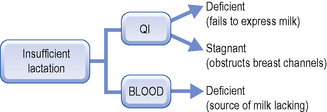CHAPTER 53 Breast Milk not Flowing (and Acute Mastitis)
Pathology
Breast milk is a product of the transformation of Qi and Blood. Milk cannot be generated without Blood, but it also cannot be generated without Qi … without Qi, breast milk cannot be transformed, without Blood it cannot be generated. Of the two, Blood is transformed into breast milk … In a woman after childbirth, Blood is exhausted … how can it be transformed into breast milk? It is due to the strength of Qi if Blood is transported and transformed into breast milk … if Qi is flourishing, milk is also flourishing, if Qi is depleted, milk is depleted.1
Breast milk is a product of the transformation of the Qi and Blood of the Directing and Penetrating Vessels: downward movement of Qi and Blood produces the menses while upward movement produces milk. When there is insufficient lactation after childbirth, it is due to Qi and Blood deficiency … which is due to the depletion of the Directing and Penetrating Vessels.2
The Stomach channel also plays a role in lactation as it controls the breast as a whole, while the Liver channel controls the nipple. Fu Qing Zhu says: “Breast milk is transformed from Yang Ming [channel] which pertains to Earth.”3
Distension, fullness and pain in the breast show that [the breast] would like to transform the milk but cannot do so, what else beside stagnant Qi could cause this? The stagnation in Bright Yang is due to shame and resentment.4
Thus, Fu Qing Zhu clearly identifies emotional problems as the chief cause of stagnation of Liver-Qi. The Literati’s Care of their Parents (Ru Men Shi Qin) by Zhang Zi He (1156–1228) also says: “Crying, weeping, sadness, anger, depression, may all cause the breast vessels not to flow.”5
Thus, we can also see the pathology of Breast Milk not Flowing in terms of Qi and Blood, with the former either deficient or stagnant and the latter only deficient (see Figure 53.1).
Identification of patterns and treatment
Qi and Blood deficiency
Treatment principle
Tonify Qi and Blood primarily: secondarily, remove obstructions from the breast Connecting channels.
Herbal treatment
a. Prescription
Explanation
Modifications
b. Prescription
c. Prescription
Explanation
This variation is recommended by Wu Qian, author of the Golden Mirror of Medicine (1742).6
The first four herbs constitute the formula Si Wu Tang which nourishes Blood.
Liver-Qi stagnation




